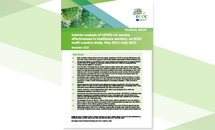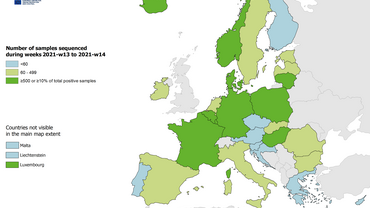Pilot study outline for targeted genomic surveillance of SARS-CoV-2 in travellers in response to a worsening or unknown epidemiological situation in a third country
This document provides practical guidance to EU/EEA Member States willing to implement a pilot study for the harmonised and coordinated targeted genomic surveillance of SARS-CoV-2 at selected international points of entry (PoE), to complement national and international genomic surveillance and to trigger more in-depth analysis at community level, such as studies for the characterisation of transmissibility, severity, and immunity evasion properties of a given virus variant.
Executive summary
On 4 January 2023, European Union (EU) and European Economic Area (EEA) countries agreed on a coordinated precautionary approach in the light of COVID-19 developments in China, especially considering the need for sufficient, reliable data and the easing of travel restrictions by China starting on 8 January 2023. The agreement included the setting up of complementary random testing of passengers travelling from China on arrival in EU Member States and the sequencing of all positive results as part of a surveillance protocol to detect virus variants of concern. This outline aims to provide guidance to Member States willing to set up this surveillance system, through pilot sentinel sites at select travel hubs for the genomic surveillance of incoming travellers from countries with a worsening of the epidemiological situation and insufficient volume of sequencing, starting with China, for a period of eight weeks. After that the results of the study will be reviewed, and the study outline will be revised accordingly.
The timely detection and characterisation of SARS-CoV-2 variants is essential to inform risk assessment and to limit the impact of the virus, e.g. by strengthening vaccination programmes or updating vaccines' composition, and by adjusting or implementing new non-pharmaceutical measures as needed. The basis of variant surveillance in the EU/EEA has been outlined in ECDC’s ‘Guidance for representative and targeted genomic SARS-CoV-2 monitoring’. Implementing targeted genomic surveillance in travellers should not result in decreasing EU/EEA Member States’ national routine respiratory virus surveillance, including sampling, and sequencing for SARS-CoV-2 and other respiratory viruses in the community. In situations of severely limited resources, routine respiratory virus surveillance in the community should take precedence over surveillance at travel hubs. Targeted genomic surveillance activities in travellers are most relevant in situations where the third country under investigation does not perform representative genomic surveillance with international sharing of relevant data.
Targeted genomic surveillance in travellers can support global SARS-CoV-2 variant monitoring through the early detection of new variants that can be further investigated with specific studies and through routine community-based surveillance. This surveillance in travellers will be complementary to wastewater surveillance activities coordinated by the European Aviation Safety Agency and the European Commission's Joint Research Centre, another initiative agreed upon by Member States as part of the coordinated precautionary approach.
There are important limitations associated with such a surveillance system. Firstly, the sampling strategy does not allow for a fully representative (geographically or otherwise) analysis of the third country population from which the samples come. In addition, epidemiological and virological investigations are required to perform risk assessment, some of which may only be possible to perform in a timely manner in the country of origin. Routine population-based representative sampling and sequencing of positive specimens from sentinel systems in primary and secondary care in EU/EEA Member States remain the most effective means of monitoring transmission and virus evolution in a timely manner in the EU/EEA, as described in the joint ‘ECDC and WHO Operational considerations for respiratory virus surveillance in Europe’.







